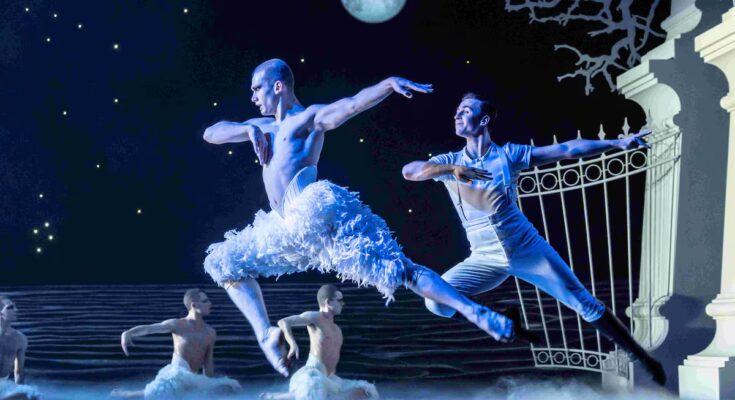Swan Lake It is certainly classical dance that holds the most crowns and interpretations, all justified, at least for what it meant originally. Nothing seemed to prefigure it in its first premiere in 1877 at the Bolshoi Theater in Moscow, when it turned out to be a total disaster because Pyotr Ilyich Tchaikovsky, composer of the music, and Julius Reisinger, author of the first choreography, did not understand each other. It was 1895 when he made his debut at the Mariinsky in St. Petersburg, with choreography by Marius Petipa and Lev Ivanov, the moment in which Swan Lake It was born as a classic on which adaptations have rained.
One of these, the one staged by the choreographer Matthew Bourne in 1995 at the head of his company New Adventures, and which he now revisits on the occasion of its thirtieth anniversary, will be seen at the Teatro Real in Madrid from Wednesday to Saturday. It is undoubtedly the best known and most revolutionary, at least at the time, due to the gender change of its protagonists. Those swans, crystallized into delicate dancers, archetypes of the most classic femininity, and that story of the most toxic romantic love between Siegfried and Odette, were dynamized by Bourne, who transformed the swans into men and the story of heteronormative love into an open and gay relationship.
November 9, 1995, the day of the premiere of this Lake, The queue to get into Sadler’s Wells in London circled the theatre. Word of mouth had spread as quickly as the famous 32 fouettes by Odile in step by step of Black Swan and Bourne’s version became a phenomenon. Seeing how the untouchable is dynamite also accompanies the reception of the classics. Critics and the public were divided between those who praised the work to the maximum and those who wondered nostalgically where the poetry and the roots were (that question of purity, which is also similar to the classics).
The production was a complete success and represented the longest running season of a ballet in London. It also won the Olivier Award and five years later, in 2000, it went viral when it appeared in the final sequence of the film Billy Elliotby Stephen Daldry. Adam Cooper, the dancer from Bourne’s company, appears in the film as Billy Elliot as an adult-turned-professional dancer whom his father goes to see perform. Thirty years later, this lake arrives in Madrid as a classic of that 1895 classic.
When his version premiered in London, Matthew Bourne clarified The Independent that his intention was not to make a parody of the classic “why no one would dare laugh at swans”. But he was wrong. Since 1974, the funny (and also challenging) company Les Ballets Trockadero de Monte Carlo, which is not from Monte Carlo, but from New York, laughed at them. In Spain they have been programmed on several occasions and, both here and wherever they go, their hooligan and comic vision of the classic, performed by men in female roles (with female costumes, make-up and accessories), usually overwhelms. Right now, the company has shows through June 2026, in the US and Europe. From his entire repertoire, which includes classics such as Paquita AND The nutcrackerhighlights the death of the swan, fragment of Swan Lake. A hilarious solo in which the disguised dancer loses his feathers. Act II and Act II of Petipa’s iconic classic are also danced pas de trois
Beyond gender change, Swan Lake It was adapted taking into account other elements, such as the character of the characters. It is the one constructed by the Swedish choreographer Mats Ek in his 1985 version, whose Siegfried is crossed by an Oedipus complex. By the way, in this adaptation of Ek, released ten years before the Bourne one, there were already men in the swan team.
That of the Swede Alexander Ekman is one of the most impressive adaptations, at least visually, among those made of this classic. Released in 2014 and structured in three parts (instead of the four acts of the original), the author uses 5,000 liters of water on stage. Two years later, another Swedish creator, Fredrik Rydman, went to the street dance to tell the tale.
From Michel Fokine’s first versions in 1911 for Diaguilev’s Ballets Russes, Frederic Ashton’s (1963) for the Royal Ballet and John Cranko (1963) for the Stuttgart Ballet, John Neumeier’s 1976 version, Jean Christophe Maillot’s 2011 version and those already mentioned, most of the choreographers who have dared to modernize this classic have been men. There have also been, although many fewer and with less recognition. In 1985, the Spanish National Dance Company, when it was still called Ballet del Teatro Lírico Nacional and directed by María de Ávila, presented the second act of the work in a version by Alicia Alonso. Four years later, with Maya Plisetskaya at the head of the formation, the ballet returned to the Spanish stage in Petipa’s original version. Marcia Haydée presented her adaptation with the Santiago Ballet in 2009. More recently, Tamara Rojo premiered choreographer Helgi Tomasson’s version in 2024 at the helm of the San Francisco Ballet, and Mar Aguiló presented a version reflective of the role of a classical dancer, in a contemporary twist, in his work. swan (2023).



